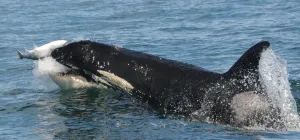(Press-News.org) Endangered Southern Resident killer whales prey on a diversity of Chinook and other salmon. The stocks come from an enormous geographic range as far north as Alaska and as far south as California's Central Valley, a new analysis shows.
The diverse salmon stocks each have their own migration patterns and timing. They combine to provide the whales with a "portfolio" of prey that supports them across the entire year. The catch is that many of the salmon stocks are at risk themselves.
"If returns to the Fraser River are in trouble, and Columbia River returns are strong, then prey availability to the whales potentially balances out as the whales have evolved to move rapidly throughout their range," said NOAA Fisheries wildlife biologist Brad Hanson, lead author of the new research. "But if most of the stocks throughout their range are reduced then this could spell trouble for the whales."
The researchers examined more than 150 prey and fecal samples collected from the whales from 2004 to 2017. This produced the most comprehensive picture yet of Southern Resident prey over the course of the year.
"When so many prey species are endangered, then they lose some of that diversity," Hanson said. "The question for managers is how do you support and improve this diverse portfolio of species and stocks."
The analysis also revealed that the whales prey almost exclusively on Chinook salmon when they are available in the summer. However, they diversify their diet the rest of the year to include species such as skates, halibut, and lingcod, as well as steelhead, chum, and coho salmon. Most of the salmon the whales consume in winter and spring come from three large river systems: the Columbia, Sacramento, and rivers entering Puget Sound.
Whales Rely on Hatchery Fish
The researchers note that increased production of hatchery fish could help support the 75 remaining whales, but that this strategy is not without risks.
Many hatchery fish are already available at certain times of the year, said Robin Baird, a research biologist at Cascadia Research Collective and a coauthor of the study. Increasing the diversity of hatchery stocks to include stocks that inhabit the whales' range in winter, when they appear to have less food, may be most helpful.
"We don't need more cookie-cutter fish that all come back during the time when Chinook are most abundant; we need to diversify and increase availability at other times of the year," Baird said.
Additional funding was provided through the federal Pacific Salmon Commission and the Washington State Legislature. The funding paid for the release of more than 11.6 million additional hatchery-origin Chinook salmon in 2020, compared to previous years. It will also pay for more than 18.3 million additional fish in 2021.
In line with the findings, the hatchery production will help maintain the portfolio of stocks, including those that overlap with the killer whales during the lean times of winter. Biologists also manage the production to avoid risk to naturally produced salmon.
The Southern Residents have historically spent much of the summer in the inland waters of the Salish Sea. There they feed almost exclusively on Chinook salmon from the Fraser River and the Skagit, Snohomish, and other rivers entering Puget Sound. In the late summer, fall and early winter, they also turn to coho and chum salmon as Chinook decline in number.
Two of the three pods--K and L pods--typically move to the outer coast in fall and winter. There they spend much of their time feeding off the Washington coast, with forays south as far as Monterey Bay in California. They likely concentrate near the Columbia River area because of the large number of returning salmon, heavily supplemented by hatchery fish, the scientists said.
They also diversify their diet with salmon from potentially as far away as the Taku River in Alaska and other species. Those fish comprise a larger share of the whales' diet than scientists first thought based on observations of the whales feeding at the surface. Biologists collected fecal samples from the whales while tracking them along the coast. The samples revealed the more complete picture, including the ocean species they consume underwater and out of sight.
The third pod, J pod, spends more time in inland waters while also traveling along the west coast of Vancouver Island. There they access a mix of salmon traveling a kind of superhighway south to West Coast rivers.
Northern Residents Pose Competition
The research also explores the Southern Residents' potential competition for prey with Northern Resident killer whales. These whales are a separate population that primarily frequents Canadian waters off Vancouver Island and north. The Northern Residents have increased in number to about 300 as the Southern Residents have declined. These opposing trends may reflect the Northern Residents' greater access to prey.
Salmon returning south from waters off Alaska and British Columbia to West Coast rivers pass through Northern Residents' range before reaching the Southern Residents. In comparing their data to results from an earlier Canadian study of Northern Residents, the researchers found that the Northern Residents consumed larger and older salmon. The largest and oldest class of salmon consumed by the Northern Residents were absent from the Southern Residents' diet.
The Southern Resident J-pod that forages to the north of the other two pods may also benefit from the same earlier access. J-pod has had a greater reproductive rate than the other pods, the study notes.
Chinook salmon are also shrinking over time along the entire West Coast, and other predators may also play a role.
"The net result is that the consistent consumption of these smaller fish, which have a lower caloric value, may pose an additional challenge to the [Southern Resident killer whale] population's ability to meet their energetic needs," the scientists wrote.
NOAA Fisheries has designated the Southern Residents one of nine national Species in the Spotlight. These species are highly endangered and can benefit from focused recovery efforts, including conservation of their prey. NOAA Fisheries West Coast Region has already applied the prey study findings in its proposal to expand critical habitat for the Southern Residents along the West Coast.
"Knowing what these whales eat throughout the year and across their various habitats helps us focus recovery efforts for both the Southern Residents and the salmon they rely on," says Lynne Barre, Recovery Coordinator for the Southern Residents at NOAA Fisheries West Coast Region.
INFORMATION:
Authors of the research include scientists from:
NOAA Fisheries Northwest Fisheries Science Center and West Coast Region
Cascadia Research Collective
Marine Ecology
Telemetry Research
Bio-Waves Inc.
Washington Department of Fish and Wildlife
Scientists from the Skoltech Center for Design, Manufacturing and Materials (CDMM) and the Institute for Metals Superplasticity Problems (IMSP RAS) have studied the fatigue behavior of additive-manufactured high-entropy alloys (HEA). The research was published in the Journal of Alloys and Compounds.
Conventional 20th century materials that are extensively used in industries and mechanical engineering have reached their performance limit. Nowadays, alloying is commonly used to improve the alloys' mechanical performance and increase their operating temperature. ...
Coastal communities at the forefront of climate change reveal valuable approaches to foster adaptability and resilience, according to a worldwide analysis of small-scale fisheries by Stanford University researchers.
Globally important for both livelihood and nourishment, small-scale fisheries employ about 90 percent of the world's fishers and provide half the fish for human consumption. Large-scale shocks -- like natural disasters, weather fluctuations, oil spills and market collapse -- can spell disaster, depending on the fisheries' ability to adapt to change. In an assessment of 22 small-scale fisheries that experienced stressors, researchers revealed that diversity and flexibility are among the most important adaptive capacity factors ...
Humans were present in Florida by 14,000 years ago, and until recently, it was believed the Bahamas - located only a few miles away - were not colonized until about 1,000 years ago. But new findings from a team including a Texas A&M University at Galveston researcher prove that the area was colonized earlier, and the new settlers dramatically changed the landscape.
Peter van Hengstum, associate professor in the Department of Marine and Coastal Environment Science at Texas A&M-Galveston, and colleagues have had their findings published in PNAS (Proceedings of the National Academy of Sciences).
Researchers generated a new ...
A detailed analysis of mental health treatment trends during the COVID-19 pandemic found a 7% increase in visits during the initial shelter-in-place period in 2020, compared with the same 3-month period in 2019.
The study, published in The Journal of Clinical Psychiatry March 3, examined patient visits for psychiatric diagnoses among members of Kaiser Permanente in Northern California.
The greatest increases in visits were for substance use (up 51%), adjustment disorder (up 15%), anxiety (up 12%), bipolar disorder (up 9%), and psychotic disorder (up 6%). Adjustment disorder is diagnosed when someone responds ...
Breakthrough greatly enhances the ultrafast resolution achievable with X-ray free-electron lasers.
A large international team of scientists from various research organizations, including the U.S. Department of Energy's (DOE) Argonne National Laboratory, has developed a method that dramatically improves the already ultrafast time resolution achievable with X-ray free-electron lasers (XFELs). It could lead to breakthroughs on how to design new materials and more efficient chemical processes.
An XFEL device is a powerful combination of particle accelerator and laser technology producing extremely brilliant and ultrashort pulses of X-rays for scientific research. "With this technology, scientists can now track processes that occur within millions of a billionth of ...
HOUSTON - (March 3, 2021) - In one of the first studies of its kind, an analysis of camera-trap data from 15 wildlife preserves in tropical rainforests has revealed a previously unknown relationship between the biodiversity of mammals and the forests in which they live.
Tropical rainforests are home to half of the world's species, but with species going extinct at a rapid pace worldwide, it's difficult for conservationists to keep close tabs on the overall health of ecosystems, even in places where wildlife is protected. Researchers found that observational data from camera traps can help.
"In general, rainforest ecosystems ...
Under the 2015 Paris Agreement, the United Nations Framework Convention on Climate Change agreed to pursue efforts to limit the temperature increase to 2.0°C and, ideally, to 1.5°C, over preindustrial levels. However, even before that treaty was signed, scientists had already warned that those "best case" targets were unlikely to be achievable. Consequently, many fire weather studies are built with models that simulate much higher levels of climate warming.
Recently, researchers from South Korea, Japan, and the United States have found that by projecting the fire weather conditions under two mildly varying warming levels -- one in which the global climate warms by 1.5°C and the other by 2°C -- even just a half-degree of warming could ...
"What scientists have achieved in a year since the discovery of a brand-new virus is truly remarkable," says Emma Hodcroft from the Institute of Social and Preventive Medicine (ISPM) of the University of Bern, first author on the piece, "but the tools scientists are using to study how SARS-CoV-2 is transmitting and changing were never designed for the unique pressures - or volumes of data - of this pandemic."
SARS-CoV-2 is now one of the most sequenced pathogens of all time, with over 600,000 full-genome sequences having been generated since the pandemic began, and over 5,000 new sequences coming in from around the world every day. ...
UNIVERSITY PARK, Pa. -- Depression can be a common problem for teens and adolescents, and while many treatments exist, they don't always work for everyone. A new study found that feeling more informed about their health may help teens take better care of themselves, leading to less depressive symptoms.
The researchers also found that trust played a factor in whether receiving health information improved depression. The more that adolescents trusted their parents or teacher as a credible source of health information, the more likely they were to ...
Bands and artists on independent record labels get less than their fair share of access to the most popular playlists on streaming platforms such as Spotify - argues a new paper from the University of East Anglia.
The paper, published today, looks at whether streaming platforms offer a level playing field for artists and record labels.
It finds that major labels have an unfair advantage when it comes to playlist access - and that they take the lion's share of subscription revenue as a result.
As a possible remedy, the research team suggests changing the payment system, so that royalties generated by individual listener subscriptions go direct to the labels, bands and artists they are listening to.
They also ...




